Entering the 20th century, cultural differences between China and the West were dramatic. Chinese art has had to make a gradual transformation from its classical form to a become a modern artistic medium.
During the past century, generations of Chinese artists exerted their utmost efforts to transform art from ancient Chinese civilizations into modern works. And then a new cultural factor -- oil painting -- entered China's art family, providing a new appearance to artistic works, growing into an indispensable artistic flower.
The difficult rough course running throughout the years exhausted five generations of painters' painstaking efforts, composing a solemn and stirring symphony in oils.
First stage in the Qing and Ming Dynasty(1542AD- 1899AD)
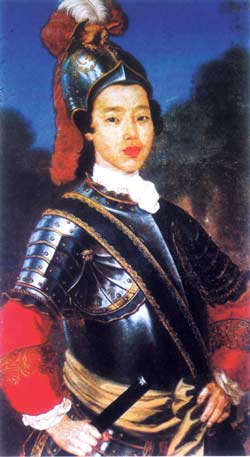
Churchmen brought oil painting to China from the West during the Ming and Qing dynasties.
Representative figure: Giuseppe Castiglione ( Lang Shining in Chinese), an Italian Jesuit missionary who came to Beijingas a missionary became royal chief artist in Kang Xi's reign of the Qing Dynasty.
Representative work: " Xiang Fei Rong Zhuang Tu" (Painting of Xiang Fei in military uniform, made in the 1920s or 1930s).
Introduction and Prevalence (1909-1949)

In the 1920s many Chinese students went abroad to study and formally brought oil painting back into China. The most well known among them are Li Shutong, Wu Dayu, Guan Liang, Xu Beihong, Li Tiefu, Liu Haisu, Lin Fengmian, Pan Yuliang, Zhu Yuanzhi Wu Zuoren, among others.
They introduced oil painting and spread modern paintings through education. From classical realism to the impressionist school, and various schools of modern art, the artistic etology grew throughout China.
Representative works: Xu Beihong's " Tian Heng Wu Bai Shi" (painted in 1929-1930)
Rebuilding the Function of Art (1949-1966)

Experiencing a baptism of war and hardships, many Chinese oil painters turned to historical subjects with the support of the central government and cultural departments. Realistic Chinese drawing grew and matured.
Representative figures: Wu Zuoren, Wang Shikuo, Luo Gongliu, Dong Xiwen and Wu Guanzhong.
Representative work: " The Founding Ceremony of China" by Dong Xiwen.
Oil painting during the Cultural Revolution (1966-1976)
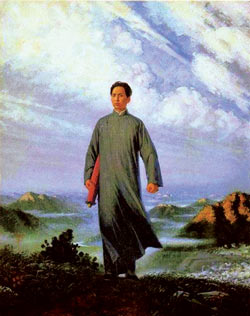
As the Cultural Revolution swept the country, Chinese oil paintings and other arts came under an unprecedented attack. Oil painting became a kind of political mark.
During that time all kinds of Mao Zedong's images as well as the praise of heroes became the main themes of each kind of artistic works.
However, even their authors could not think, after several years, those kinds of works became the main source for " political pope picture" and stepped onto the international painting world.
Representative figures: Liu Chunhua, Tang Xiaohe, Tang Xiaoming and Chen Yifei.
Representative work: "Chairman Mao Goes to Anyuan" by Liu Chunhua in 1967
Stretching and Transition (1977-1984)
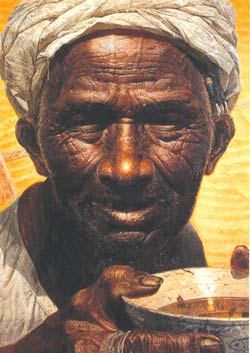
Coming out of the shadows of the Cultural Revolution, oil painting started to divorce itself from the fetters of politics and explored a new form of beauty.
It entered a new stage in the 1980s. Painting styles changed dramatically under the influence of the reform and opening policy. Vigorous young painters created some realist works such as "Father" and the group painting, "Tibetans."
Representative figures: Chen Yifei, Cheng Conglin, Luo Zhongli, Chen Danqing,He Duoling, Ding Fang and Shang Yang.
Representative works: Luo Zhongli's "Father," a milestone of rural portrait .
Time of great passion (1985-1989)
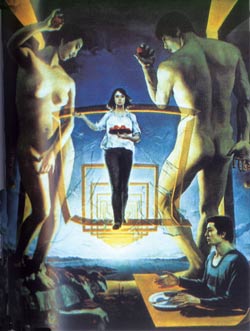
In the mid-1980s, Western Culture and art poured into China, exerting great influence on Chinese oil painting. It provided opportunities for Chinese painters to absorb new skills from Western paintings. Some young painters showed great interest in modern Western painting schools and started to imitate their styles, establishing a painting trend called the '85 New Trend (because the trend was most popular in 1985).
Representative figures: Zhang Qun ,Meng Luding, Li Shan, Zhang Xiaogang, Wang Xuhui, Wang Guangyi, Jin Shangyi.
Representative work: Zhang Qun and Meng Luding's " Enlightenment of Adam andEve in the New Age, " which is the most remarkable work combining symbolism and Western Surrealism
Rapid development (1900-2000)
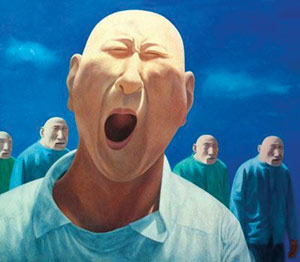
The Reform and Opening up Policy brought a historical transition to China, and also celebrated the development of oil painting. Artists began to high on explaining the innermost feelings and strive for changing. During those 10 years, emerged many new painting styles, such as a political pope, cynical realism, colorful vulgar art, new expressionism and others.
Representative figures: Wang Guangyi, Zhang Xiaogang, Fang Lijun, Liu Xiaodong, Feng Zhengjie, Shang Yang, Shi Chong.
Representative work: Fang Lijun's "Large Head Series"
Future of Chinese oil painting
In the five years of the new century, a generation born around the 1980s began to appear in art circles. At the same time many Chinese artists were seeking a harmonious blend of east and west, as well as the classical and modern. They tried their best to create a kind of Chinese oil painting with a spirit of local color and age.
Author:Ivana










